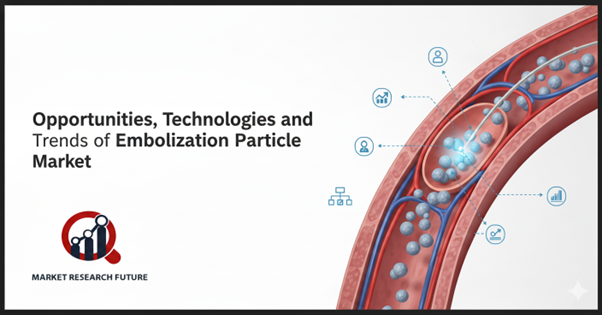Opportunities, Technologies and Trends of Embolization Particle Market

The market for embolization particles is growing steadily because more people want minimally invasive treatments, and interventional radiology is getting better. These tiny particles play a crucial role in blocking blood flow to specific areas, such as tumors or abnormal blood vessels, making treatments more effective while reducing the risks associated with traditional surgery.
Embolization particles are commonly employed to stop blood flow to specific regions, including tumors or vascular abnormalities. This makes treatments more effective and lowers the risks of surgery.
The market is changing because more people are learning about these processes, and new technologies are coming out.
Embolization Particle Market Overview
Embolization particles are small, biocompatible materials used in procedures including treating liver cancer, managing vascular malformations, and embolizing uterine fibroids. There are many kinds, such as polyvinyl alcohol (PVA) particles, microspheres, and particles made of gelatin. The choice of which one to use relies on the ailment being treated and how precise the treatment needs to be.
Embolization Particle Market Trends
The market is going toward more advanced particle designs and materials that are safe for living things. Microspheres and drug-eluting particles are becoming more popular because they can offer tailored therapy and help patients get better.
Minimally invasive techniques are better than regular surgery because they shorten recovery times and hospital stays. Also, combining with imaging technologies like CT and MRI makes it possible to administer embolization particles more accurately, which improves the precision of treatment.
What Drives the Embolization Particle Market?
Here are the most common reasons that are fueling the growth of the Embolization Particle Market.
The growing number of malignancies and vascular illnesses is driving up the need for embolization therapy. New delivery devices and imaging-guided treatments in interventional radiology make things safer and more effective. Patients prefer minimally invasive treatments because they lower the risks of surgery, speed up recovery, and improve quality of life.
More and more doctors and patients are learning about the benefits of embolization procedures, which helps the market grow. Technological Innovations: Creating particles that are biocompatible, release drugs, and fit certain shapes improves therapy results.
Emerging Technologies in the Embolization Particle Market
Janus Particle-Engineered Structural Lipiodol Droplets: A 2023 study introduced Janus particle lipiodol droplets that are highly deformable and effectively block blood vessels. In animal models, they outperformed traditional embolic agents, maintaining vessel occlusion for 14 days, showing promise for long-term, targeted embolization.
Hydrogel-Based Embolic Agents: Hydrogel-based embolic agents offer biocompatibility and adaptability to vascular structures. Recent advances, including dual-crosslinked formulations, improve mechanical stability and controlled degradation, enabling precise, sustained embolization, especially in complex vascular networks.
Polyvinyl Alcohol (PVA) Particles: PVA particles remain widely used in embolization. Recent research focuses on optimizing size and uniformity to enhance targeting accuracy and reduce non-target effects, with studies demonstrating successful treatment of distal coronary artery perforations.
Embolization Particle Market Opportunities
Emerging Markets Expansion: Asia-Pacific and Latin America have a lot of room to grow because their healthcare infrastructure and access are getting better.
Drug-Eluting Embolization Particles: An innovative field is developing that delivers chemotherapy drugs directly to tumors.
Combination therapies: Using embolization particles with immunotherapy or radiotherapy can make treatment work better.
Research and Development: New product launches are possible since particle design and delivery mechanisms are always changing.
Home-Based and Outpatient Procedures: Expanding outpatient embolization services can make healthcare more affordable and easier to access.
What to Expect in the Future
The market for embolization particles is likely to keep growing steadily because of new technologies and more people learning about minimally invasive therapies. Healthcare professionals can give safer and more effective treatments as drug-eluting particles, imaging-guided devices, and combination medicines become increasingly popular.Emerging markets and new ways to construct particles will keep creating opportunities, which will keep the worldwide embolization particle market growing.